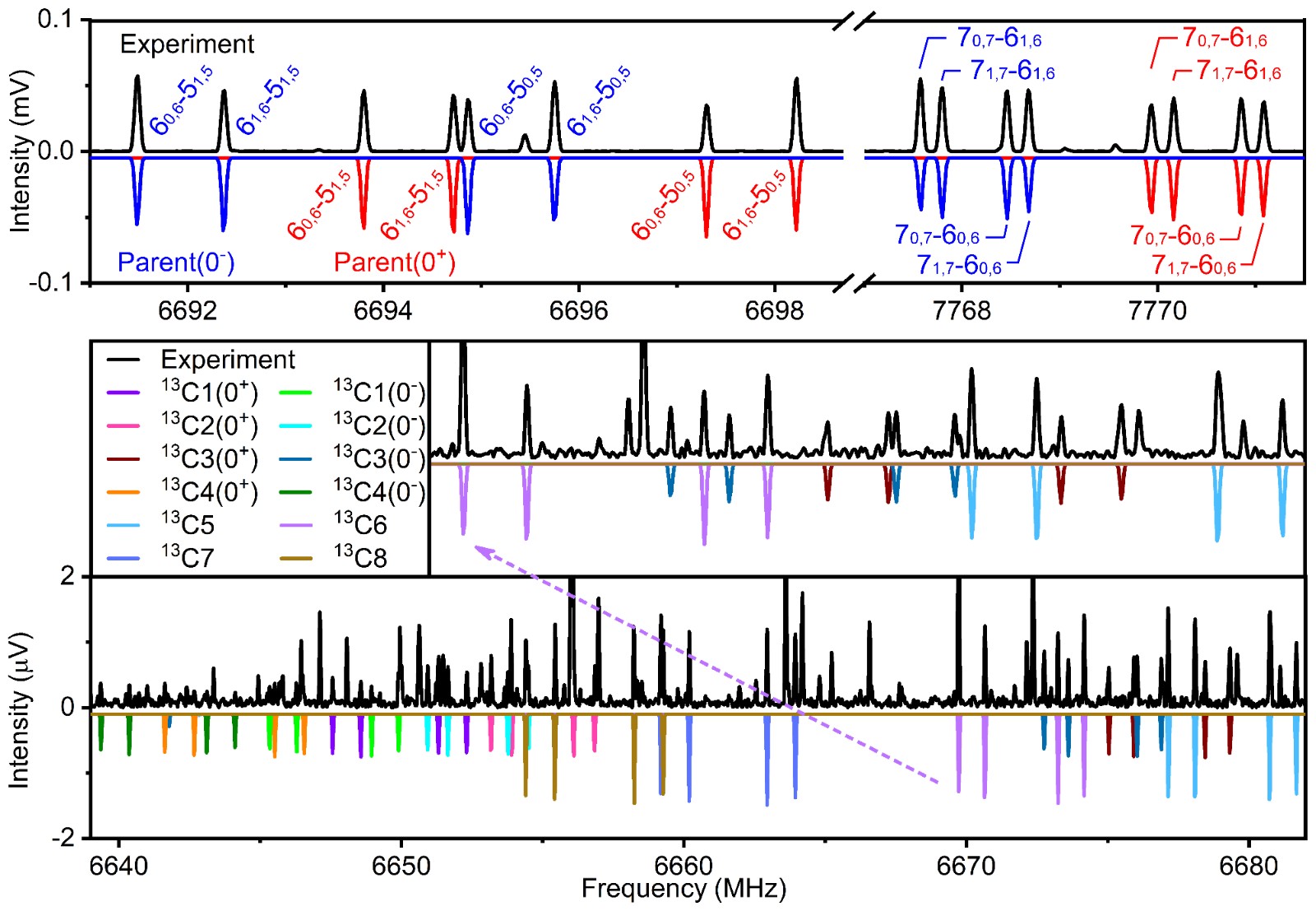We are interested in the spectral studies of reaction intermediates, free radicals and atomic or molecular clusters, which are important in many chemical processes such as combustion or atmospheric chemistry, and catalysis. These species are produced in a low temperature Ar or Ne matrix, or in a pulsed laser evaporation-supersonic molecular beam. Several detection methods are employed including infrared absorption spectroscopy, infrared photodissociation spectroscopy, microwave spectroscopy and electron spin resonance spectroscopy. Computational chemistry methods are employed to complement the experimental work. The combined spectroscopic measurements and computational work provides definitive answers about molecular structure, electronic structure, bonding energetics and the reactivity of these systems.
课题组专注于反应中间体、自由基、原子或分子团簇的光谱研究。主要使用基质隔离红外吸收光谱、质量选择的红外光解离光谱、微波光谱以及顺磁共振谱等多种谱学实验方法,并结合理论计算,来获得分子几何和电子结构、成键及反应特性等信息。
Matrix Isolation Infrared Spectroscopy
The matrix-isolation technique has served to produce and to trap transient species in diverse chemical and physical problems since its inception in 1954. In addition to its capability of trapping and preserving unstable species, the matrix-isolation technique has an additional advantage in accumulating the sample via continuous deposition for a protracted period to facilitate detection of weak absorptions due to a small cross section or small concentration. Furthermore, the sample required in the experiment is small relative to that in gas-phase experiments; use of precious samples such as isotopic variants and specially synthesized precursors thus becomes feasible. Fourier-transform infrared absorption spectroscopy is commonly employed in conjunction with the matrix isolation technique to characterize transient species trapped in solid matrixes. Vibrational spectroscopy is bond specific and can identify new species particularly when isotopic substitution is employed.
基质隔离红外光谱
基质隔离(Matrix Isolation)技术最早于1954年由Pimentel教授等提出。其基本原理是在接近绝度零度(4K – 20K)的低温条件下,利用大量的惰性基质(如稀有气体,N2等)来捕获一些反应中间体和自由基等活性物种(又称客体分子)。由于低温下惰性气体凝固成刚性晶体,使得在通常实验条件下(常温、常压)不能稳定存在的瞬态分子物种被有效稳定下来,从而可以利用红外吸收光谱和顺磁共振等谱学手段进行探测。由于振动光谱与分子结构和化学键关系密切,傅里叶变换红外光谱是最常用的与基质隔离技术相结合的谱学探测手段,结合同位素取代技术可以有效获得瞬态物种的结构信息。
实验装置原理示意图以及典型基质隔离红外光谱图:


Infrared Photodissociation Spectroscopy
By comparison with conventional absorption spectroscopy that involves the measurement of a small change in a large signal due to radiation transmitted through an absorbing material, causing a condition of a large background that results in a small sensitivity, infrared photodissociation spectroscopy is a sensitive method in studying mass-selected molecular and cluster ions in the gas phase. The ions or clusters produced in a pulsed laser evaporation supersonic molecular beam source are size-selected with a specially-designed time-of-flight mass spectrometer. The mass selected cluster ions overlaps with a pulsed focused IR laser beam. When the IR laser is resonant with an IR-allowed vibrational mode of the cluster, single or multiple photon absorption can take place. If the cluster gains enough energy to overcome its barrier for dissociation, cluster fragmentation becomes possible. Infrared photodissociation spectra are obtained by monitoring the fragment ion signal.
红外光解离光谱
红外吸收光谱灵敏度低,很难用于数密度非常低的气相离子等的红外吸收光谱探测。随着质谱技术和可调谐红外激光技术的发展,红外光解离光谱(infrared photodissociation spectroscopy, IRPD)已发展成为一种功能强大的气相离子振动光谱探测方法。振动光谱可以为气相离子的研究提供丰富的结构信息,比如电荷的分布、判断包含的官能团、离子的结构和对称性、蛋白质中的二级结构和氢键等弱相互作用力。本课题组研制了配备脉冲激光溅射-超声分子束载带团簇离子源的基于串级飞行时间质谱技术的红外光解离光谱装置。实验装置示意图以及典型的红外光解离光谱图:


Molecular rotational spectroscopy utilizes electromagnetic radiation, typically in the microwave region, to measure the transition energy between the quantized energy levels that come from the rotational kinetic energy of a polar molecule in gas phase. The rotational energy levels and spectral patterns are determined by the principal moments-of-inertia of the molecule and are, therefore, directly related to the mass distribution relative to the molecular center-of-mass. The fact that the rotational spectroscopy is related to the mass distribution, and not just the mass number, makes molecular rotational spectroscopy ideally suited for structure analysis.
Depending on the frequency range of a single spectral acquisition event, the technique has been divided into “narrowband” and “broadband” rotational spectroscopy since the invention of the “broadband” chirped pulse Fourier transform microwave (CP-FTMW) spectroscopy in 2008 by Brooks H. Pate et al. The “narrowband” spectroscopy usually covers around 1 MHz spectral width while the “broadband” can measure over 10 GHz frequency range in one shot.
In our lab, we have built up the “broadband” CP-FTMW spectrometer working in the frequency range of 2-8 GHz. A linear sweep chirped pulse (several microseconds) from 2 to 8 GHz is generated by an arbitrary waveform generator (AWG, 25GS/s) and then amplified by traveling-wave tube amplifier (TWTA, 300 watts). The amplified microwave pulses are broadcasted into vacuum chamber by a horn antenna, then interact with the cold molecular beam and create macroscopic polarization in the sample by aligning the molecular dipole moments. After the excitation pulse dissipates, the radiation waves will be coherently emitted by the rotationally excited molecules. This coherent emission eventually decays through Doppler dephasing or collisions. The broadband free-induction decay (FID) signals are collected by another horn antenna and accumulated by using a high-speed oscilloscope (100GS/s). The molecular rotational spectrum is produced by subsequent Fourier transform analysis of the time-domain signals.
微波光谱
微波光谱是利用微波波段电磁波测量气相中极性分子的转动能级之间的跃迁。分子转动能级及光谱是由分子转动惯量决定的,其与分子的质量分布直接相关,因此微波光谱是研究分子结构的理想手段。微波光谱利用25GS/s的任意波形发生器产生一段脉宽为几微秒,频率覆盖2-8GHz的线性扫频信号(啁啾脉冲),随后经过300瓦行波管放大器,然后由一个宽带喇叭形天线发送到真空腔中。在真空腔中,微波与经超声膨胀冷却的分子相互作用,同时激发分子的不同转动量子态。在微波脉冲辐射消散后,处于不同转动激发态的分子跃迁回其初始量子态,同时向外发射电磁波信号。此信号被真空腔体内另一端的宽带喇叭天线接收,经过低噪音放大器后传送给100GS/s的示波器收集并平均,最后收集的时域信号经过傅里叶变换形成频谱。微波光谱可以用来探究原子核超精细结构、电荷分布、分子手性、量子态调控等科学问题。
实验装置原理示意图以及典型微波谱图:


顺磁共振
顺磁共振是测量和表征具有磁性物质的主要实验方法。由于自旋运动,电子具有磁矩,当分子中的所有电子都两两配对的时候,电子的磁矩互相抵消,该分子组成的物质不会表现出宏观磁矩。当某个分子或者物质具有未配对的单电子的时候,物质的具有宏观净磁矩,表现出顺磁性或者铁磁性。当该物质处于外磁场中时,由于Zeeman效应,电子磁矩与外磁场的不同取向状态导致能级分裂为能量较低的基态和能量较高的激发态,利用微波激发可以使电子磁矩状态从基态跃迁到激发态,通过扫描外磁场可以获得顺磁共振谱。





